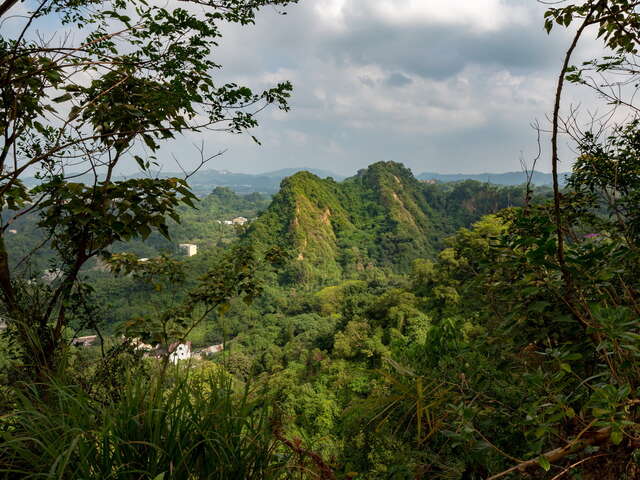Guanyin Mountain Scenic Area, Guanyin Lake Introduction
Guanyin Mountain, located at the intersection of Renwu and Dashu districts, was formerly known as "Cui Ping Rock." With a height of only 177 meters, it is one of the top ten famous mountains in Kaohsiung and is numbered 075 in the list of minor mountains. The name comes from the main peak resembling Guanyin sitting and the surrounding peaks encircling it, making it a popular choice for exercise, outings, and religious pilgrimages, especially crowded with visitors on weekends. The Guanyin Mountain area is vast, mostly consisting of rich iron-bearing fine sandstone that is soft and suitable for barefoot walking, hence it is also known as Barefoot Park. In addition, there are the famous "Eight Scenic Spots of Guanyin," including Cui Ping Sunset, Golden Bell Spirit Platform, Stone Drum Shaking the Mountain, Ancient Tree Immortal's Trace, Stone Brush Beginning to Open, Guanyin Soaring to the Sky, Lotus Pond Night Moon, and Heaven Cave Morning Dawn, each with its unique beauty. There are many hiking trails on Guanyin Mountain. For first-time climbers, it is recommended to plan a popular trail route, which can start from the parking lot at Guanyin Mountain's seventh public parking area and begin the ascent at the "Fengyi Palace" trailhead. Although the stone steps are steep and challenging to climb, the scenery improves with the height, allowing for breaks to enjoy the beautiful views. Upon reaching the highest point of Guanyin Mountain, visitors will see the wartime tunnel "Heaven Cave" excavated during the Japanese occupation, which is part of the Eight Scenic Spots of Guanyin. The Guanyin Pavilion nearby is a common resting place for hikers, where one can take pictures at the observation platform and "triangular point," with views of Guanyin Mountain's North Peak and Middle Peak. This route is the quickest way to the summit of Guanyin Mountain. Continuing downhill leads to "Environmental Park," which is spacious and flat, equipped with public restrooms. As visitors descend further, they will encounter some vendors, offering the chance to enjoy refreshing natural aiyu jelly that cools off the summer heat. The weekend market at "Dajue Temple" provides an opportunity for shopping. This route is the shortest hiking path on Guanyin Mountain, approximately 2.5 kilometers long, which takes about one hour to complete at a leisurely pace. Guanyin Lake is located to the south of Guanyin Mountain. Originally named Governor's Pond, the lake features calm and clear waters and a rich ecological environment that attracts many migratory birds. Guanyin Lake spans 30 hectares and is divided into inner and outer lakes, serving functions for irrigation, water storage, and flood control. This hidden gem, with its beautiful mountains and waters, is a must-visit after hiking the trails of Guanyin Mountain. Eight Scenic Spots of Guanyin: 1. Cui Ping Sunset: At the foot of Guanyin Mountain, there is a huge rock surrounded by mountains on three sides, which collects the wind and spirit. It is said that Emperor Kangxi of the Qing Dynasty named this place "Cui Ping Rock" for its beautiful scenery. The "Cui Ping Sunset," one of the Eight Scenic Spots of Fengshan, refers to this viewpoint. Hiking Guanyin Mountain is pleasant during the day, but witnessing the stunning twilight at dusk gives a firsthand experience of the beauty of "Cui Ping Sunset." The "Cui Ping Sunset" has been listed among the scenic spots in the Fengshan region since the 20th year of Guangxu. 2. Golden Bell Spirit Platform: Located thirty meters southeast from the starting point of Xuefu Road, the road was widened, reducing its size by half. A stairway leads to an ancient pavilion, which has an anonymous couplet describing the legendary story of the Cui Ping Rock Temple. 3. Stone Drum Shaking the Mountain: Located outside the wall to the south of Dajue Temple, there were once springs emerging in the 1940s. Due to renovations at Dajue Temple in the 1990s, this spot has now been transformed into an artificial waterfall. It is said that in the past, when the temple rang the bell and beat the drum during teachings, the echoes of the stone drum would shake the mountains. 4. Ancient Tree Immortal's Trace: The ancient banyan tree used to grow on the stone drum, providing shade for dozens of resting people. It began to wither in the 1960s and died out in the 1980s due to illness and pests. The banyan tree seen today was planted in the 1980s. 5. Stone Brush Beginning to Open: This feature arises in a basin by the ancient well of sweet spring along the northern section of the mountain trail, resembling a stone stalagmite, about 30 meters high, with the end resembling brush bristles. During the full moon, the brush shaft reflects moonlight while the tip appears dark, standing out impressively. 6. Guanyin Soaring to the Sky: The highest peak of Guanyin Mountain, known as Zhouzi Kengwei, resembles Guanyin sitting in meditation, offering views from Anping to Fangbitou. The mountain has undergone three rounds of leveling, with the first during the Japanese occupation for building a fortress; the second in the 1970s by the military for constructing a water reservoir; and the third in the 1990s, when a wooden observation platform was built. 7. Lotus Pond Night Moon: Located in front of Guanyin Soaring to the Sky, the northern Kidzi Pond can irrigate about 43 hectares and has been reduced in size; the southern Dapei has been divided into several smaller ponds. This area is closest to Guanyin Mountain, contributing to its name. 8. Heaven Cave Morning Dawn: Towards the end of World War II, the Japanese excavated a wartime tunnel about 100 meters long on Zhouzi Kengwei, leading west to east. On this mountain ridge, one can gaze at the layered peaks awash in the morning sun.



























